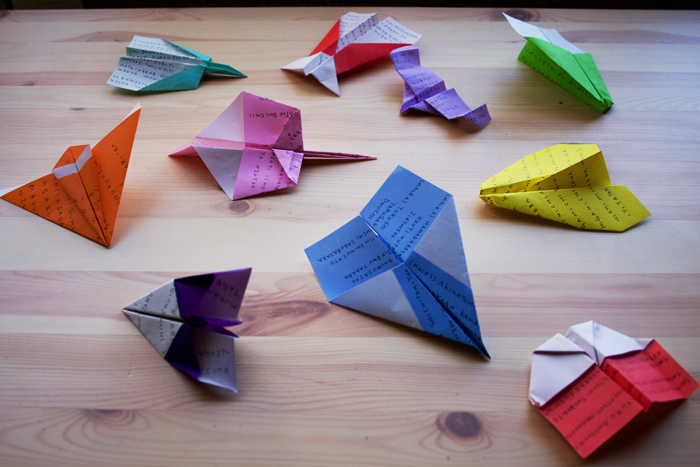Untitled(Fighter Jets) | 無題(戦闘機)
Works | 2008年08月22日(金)
「What Lies」 (『忘れられたものたちへの歌、2008』より)の背景の有刺鉄線は、辺野古とキャンプ・シュワブを隔てるフェンスです。ヘリポート問題などで物議を醸したこのフェンスには、色とりどりののピースリボンや抗議バナーがところ狭しと付けられ、静かに風に揺れています。
『忘れられたものたちへの歌、2008』を制作している最中、僕は軽い気持ちで、沖縄民謡の中のラブソングをアルファベットで書いて、それを紙飛行機にしてフェンスの向こう、基地の中に飛ばせたら良いな、と考えました。もしかしたら、アメリカ兵か誰かが拾ってくれるかもしれない、と。
しかし実際そこへ行くと怖くてフェンスに近づく事も出来ませんでした。向こう側からは、監視カメラがこちら側を凝視しています。有刺鉄線は、あくまで無骨で否定的。そこへ近づく事すらできずに、僕はその紙飛行機をフェンスからはかなり離れたビーチの上に置く事しか出来ませんでした。フェンスは、僕が思っていたよりもずっとずっと重い意味を持ってしまっていたのです。
その後、似たような紙飛行機を作り始めました。いくつものラブソングたちを載せた紙飛行機。アルファベットに変換された、沖縄民謡のラブソング。こちら側に残り、絶対に受取手に向かい飛んでゆく事のない、既に否定されたラブソングたち。
—
In the background of “What Lies” (from Songs for the Forgotten, 2008) is the barbed-wired fence that divides an Okinawan Town of Henoko and Camp Schwab, an American military base. Since the U.S. and Japanese governments decided to construct heliport offshore the beach where it stands, people have started to put wish ribbons and protest banners on it. (The constructions is said to destroy the last habitat of endangered dugongs)
While executing Songs for the Forgotten, 2008 series I thought it would be nice if I could fly a paper plane, with an Okinawan love song written on it, over the fence, so that perhaps some American would pick it up. Yet when I got there, I got scared, there was a surveillance camera watching this side from the other side, and the barbed wire was crude and rejecting. Not being able even to get closer to the fence, I left my paper plane far off of it. The fence had much greater significance than I imagined, to those whose lives are constantly affected by the base.
After that, I started to make more paper planes loaded with Okianwan traditional love songs. Already-rejected loves songs that stay on this side, that won’t reach their recipients.
